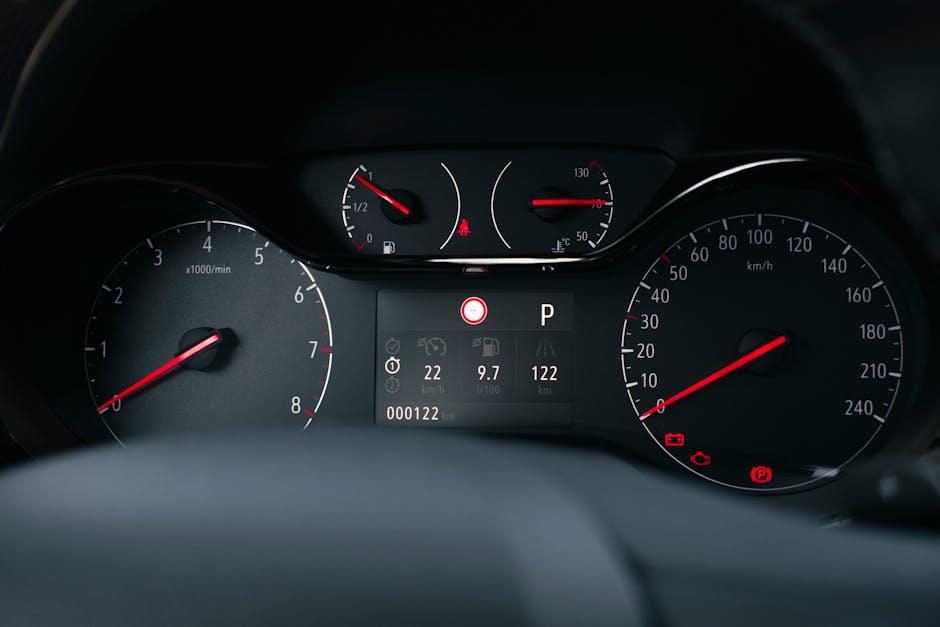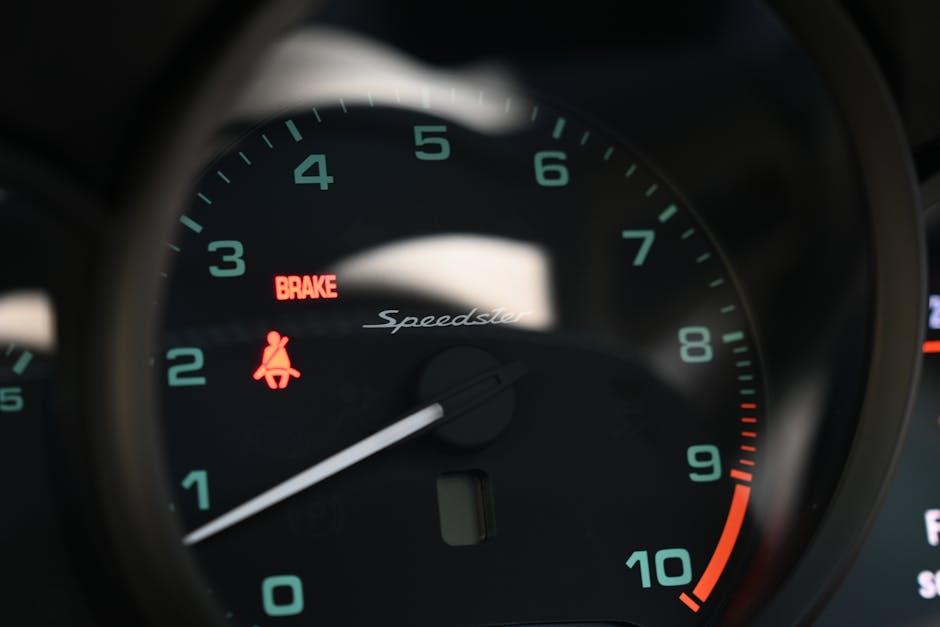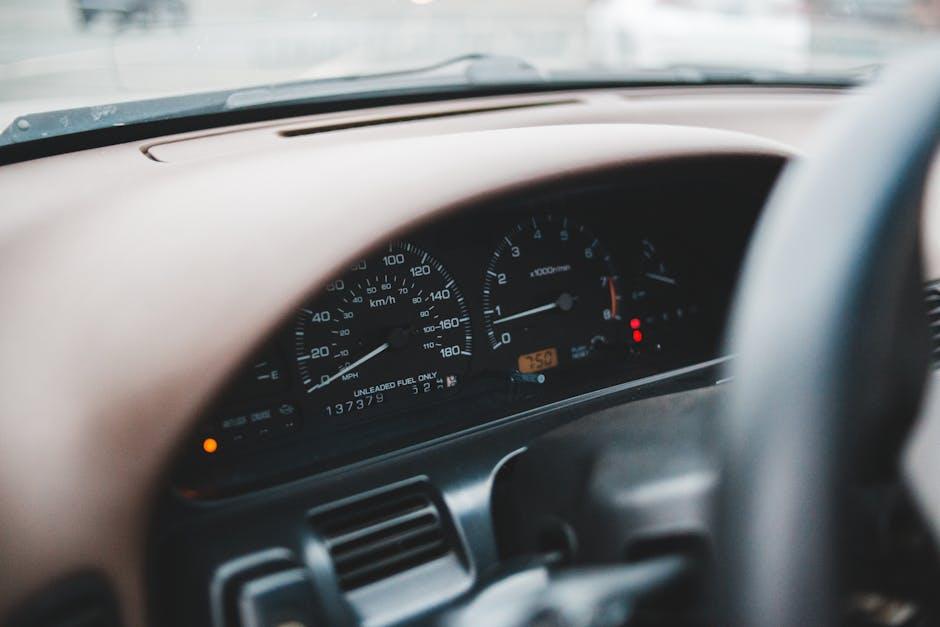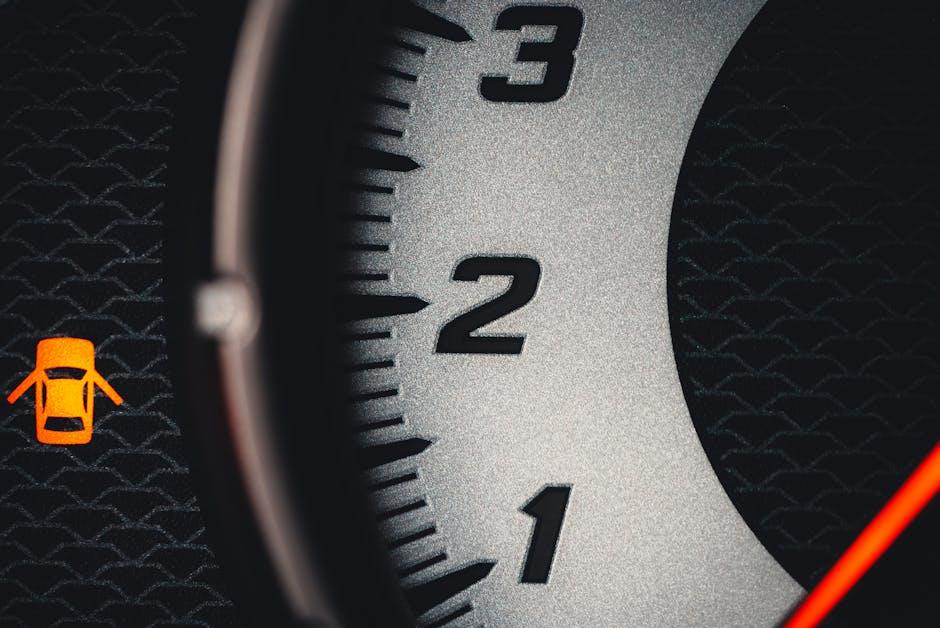Every time you slide behind the wheel and catch the sudden glow of a warning light on your dashboard, a flicker of unease ripples through your mind. That little icon, often overlooked until it blinks ominously, is your car’s way of speaking up — signaling that something beneath the hood needs attention. But before panic sets in or you rush to a mechanic, there’s a world of understanding you can tap into. In this article, we’ll explore how to decode and fix those warning lights, transforming them from cryptic alerts into manageable fixes that keep you safely on the road. Whether it’s a simple reset or a deeper dive into your vehicle’s health, let’s demystify those dashboard signals together.
Table of Contents
- Understanding the Meaning Behind Common Dashboard Warning Lights
- Diagnosing the Root Cause with Basic Vehicle Checks
- Using Onboard Diagnostics Tools for Accurate Readings
- Step-by-Step Guide to Resetting Warning Lights Safely
- When to Seek Professional Help for Persistent Alerts
- Preventative Maintenance Tips to Avoid Future Dashboard Warnings
- Q&A
- In Summary

Understanding the Meaning Behind Common Dashboard Warning Lights
Every dashboard warning light is a vital communicator, signaling your car’s condition and helping you avoid costly repairs. Symbols like the check engine light or the oil pressure warning may seem scary at first, but understanding what they represent can empower you to take prompt, effective action. For example, a blinking check engine icon often indicates a serious emissions problem that needs immediate attention, while a steady glow might mean a minor sensor issue. Recognizing these nuances can prevent breakdowns and keep your vehicle running smoothly.
Here’s a quick guide to some common symbols and their meanings:
- Battery Light: Indicates charging system problems—think alternator or battery issues.
- Temperature Warning: Signals engine overheating, which requires immediate cooling system checks.
- Tire Pressure: Alerts you when tire pressure drops below safe levels, affecting both safety and fuel efficiency.
| Warning Light | Meaning | Recommended Action |
|---|---|---|
| Check Engine | Emission or engine issue | Run diagnostics or visit mechanic |
| Oil Pressure | Low oil pressure | Check oil level immediately |
| Brake Warning | Brake system or fluid issue | Inspect brake components promptly |

Diagnosing the Root Cause with Basic Vehicle Checks
Start by examining the most common and easily overlooked factors that trigger dashboard warning lights. Check your vehicle’s fluid levels first, including engine oil, coolant, brake fluid, and transmission fluid. Low fluid levels can cause sensors to send warning signals to your dashboard. Next, inspect the battery terminals for corrosion or loose connections, which can lead to electrical malfunctions affecting the dashboard alerts. Don’t forget to assess your tire pressure, as some cars monitor tire conditions and can trigger alerts if pressures fall below recommended levels.
Another simple yet effective step is to conduct a visual inspection under the hood. Look for damaged or disconnected wires, cracked hoses, and leaking fluids, all of which could create issues that provoke dashboard warnings. Below is a quick reference table summarizing these basic checks:
| Basic Check | What to Look For | Potential Warning Light |
|---|---|---|
| Engine Oil Level | Low oil or dark, dirty oil | Oil Pressure/ Check Engine |
| Coolant Level | Below minimum mark | Temperature/ Engine Coolant |
| Battery | Corrosion, loose terminals | Battery/ Charging System |
| Tire Pressure | Below recommended PSI | TPMS (Tire Pressure) |

Using Onboard Diagnostics Tools for Accurate Readings
Modern vehicles come equipped with sophisticated onboard diagnostics (OBD) systems that provide detailed insights into your car’s health. Utilizing a reliable OBD tool allows drivers and mechanics to pinpoint the exact cause behind various dashboard warning lights with minimal guesswork. These devices connect to your vehicle’s diagnostic port and retrieve error codes, which correspond to specific malfunctions or maintenance needs. By understanding these codes, you can make informed decisions—whether it’s scheduling repairs or even fixing minor issues yourself.
To get the most accurate readings, ensure your OBD scanner is compatible with your vehicle model and regularly updated with the latest software. Here’s a quick checklist to enhance your diagnostic process:
- Choose a scanner with live data streaming for real-time engine performance feedback.
- Refer to an OBD code lookup table to decode the error messages efficiently.
- Clear error codes after addressing issues to verify if repairs were successful or if further attention is required.
| Common OBD Codes | Meaning | Suggested Action |
|---|---|---|
| P0171 | System Too Lean (Bank 1) | Check for vacuum leaks or fuel delivery problems |
| P0420 | Catalyst System Efficiency Below Threshold | Inspect catalytic converter and oxygen sensors |
| P0300 | Random/Multiple Cylinder Misfire Detected | Test ignition system components |

Step-by-Step Guide to Resetting Warning Lights Safely
Before tackling any dashboard warning lights, ensure your vehicle is parked in a safe, well-ventilated area with the engine off to prevent any accidental hazards. Start by consulting your owner’s manual or a reliable online resource to understand what each warning light symbolizes. This knowledge is crucial, as it directs you whether a simple reset will suffice or if professional attention is necessary. Equip yourself with basic tools, such as an OBD-II scanner, which can read diagnostic trouble codes and help clear minor alerts manually without risking your vehicle’s health.
Follow these key actions to reset warning lights efficiently and safely:
- Turn the ignition key to the “On” position without starting the engine to power the electronic system.
- Use the OBD-II scanner to read codes and note down any error messages.
- Clear the codes via the scanner to reset the dashboard lights; if the warning persists, further diagnostics are required.
- Disconnect the battery for 15 minutes as an alternative reset method, but note this may erase saved settings.
- Restart the engine and observe if the light turns off or comes back on promptly.
| Warning Light | Suggested Reset Method | Recommended Action if Not Reset |
|---|---|---|
| Check Engine | Use OBD-II scanner | Visit mechanic for diagnostics |
| Oil Pressure | Reset after oil change | Check oil levels immediately |
| Battery | Disconnect battery briefly | Inspect charging system |

When to Seek Professional Help for Persistent Alerts
Sometimes, dashboard warning lights refuse to turn off despite your best efforts. If you notice that the alerts persist after performing basic resets or routine checks, it’s a clear signal that the issue could be more complex than a simple malfunction. Ignoring these persistent lights can lead to costly repairs or even compromise your safety on the road. In such cases, don’t hesitate to seek professional diagnosis—technicians have the advanced tools to pinpoint faulty sensors, wiring problems, or hidden mechanical faults that evade standard DIY fixes.
Keep an eye out for these key indicators that professional intervention is necessary:
- Flashing warning lights – Often a sign of serious engine or transmission issues that demand immediate attention.
- Recurring alerts within hours or days – Suggests that underlying problems haven’t been properly addressed.
- Multiple warning lights simultaneously – Could indicate an electrical system failure requiring expert troubleshooting.
- Change in vehicle performance or unusual noises – Paired with dashboard alerts, this can mean a deteriorating condition that endangers vehicle integrity.
| Alert Type | Suggested Action | Possible Cause |
|---|---|---|
| Check Engine Light (Flashing) | Immediate professional diagnostics | Severe engine misfire or catalytic converter damage |
| Battery/Charging Warning | Battery health and alternator check | Alternator failure or battery degradation |
| Brake System Alert | Brake system inspection and repair | Low brake fluid or worn brake pads |

Preventative Maintenance Tips to Avoid Future Dashboard Warnings
Ensuring your vehicle remains free from annoying dashboard warnings requires more than just reactive fixes. Regular inspections and upkeep can save you from costly repairs and unexpected breakdowns. Start by keeping an eye on critical fluid levels—engine oil, coolant, brake fluid, and transmission fluid should be monitored frequently. A well-lubricated engine and proper fluid balance prevent sensor alerts and overheating, two common causes of dashboard warnings. Additionally, don’t overlook basic upkeep like replacing worn-out air filters, spark plugs, and brake pads. These simple actions help maintain engine efficiency and system health, keeping those warning lights at bay.
Incorporate a routine maintenance schedule that addresses both the engine and electronic systems, as modern cars heavily rely on sensors to gauge performance. Here’s a quick checklist to keep your dashboard calm:
- Clean battery terminals to prevent electrical glitches
- Check tire pressure regularly for optimal sensor readings and safety
- Update onboard software when recommended by your manufacturer
- Inspect belts and hoses for signs of wear and replace proactively
- Schedule professional diagnostics at least once a year to catch hidden issues early
| Maintenance Task | Frequency | Benefits |
|---|---|---|
| Engine Oil Check | Monthly | Prevents overheating and sensor errors |
| Tire Pressure | Bi-weekly | Maintains fuel efficiency and brake system accuracy |
| Battery Health Inspection | Every 6 months | Avoids unexpected electrical warning lights |
Q&A
Q&A: How to Fix Dashboard Warning Lights
Q1: What do dashboard warning lights really mean?
A1: Dashboard warning lights are your car’s way of speaking up—each color and symbol is a coded message about your vehicle’s health. They can indicate everything from minor issues like a loose gas cap to serious problems like engine malfunctions. Think of them as a visual check-engine dribble, urging you to take action.
Q2: When I see a warning light, should I panic or stay calm?
A2: Stay calm but don’t ignore it. Some lights—like the oil pressure or engine temperature warnings—mean you should stop driving immediately to prevent damage. Others, such as the tire pressure or service engine soon light, suggest you need to schedule maintenance soon. Your car is giving you a heads-up, not a heart attack.
Q3: How do I identify what each warning light means?
A3: Your car’s manual is the best friend here. It deciphers the cryptic symbols and explains each light’s urgency. Additionally, many modern cars have apps or online resources where you enter your model year and get a detailed dashboard light glossary.
Q4: Can I fix a warning light issue by myself?
A4: Sometimes, yes! Simple fixes like tightening the gas cap, inflating tires to the correct pressure, or replacing a burned-out bulb can turn that light off. If the light persists or relates to complex systems (ABS, airbags, engine), it’s safer and more effective to consult a professional mechanic.
Q5: What tools might I need for basic dashboard warning light troubleshooting?
A5: A good start is an OBD-II scanner—this nifty device plugs into your car and reads fault codes that trigger warning lights. Combined with your manual, it can help diagnose the issue. For basic fixes, gloves, a wrench set, and a tire pressure gauge often come in handy.
Q6: Is it okay to drive with a warning light on?
A6: It depends on the light. Yellow or orange lights often mean caution—you can usually drive carefully to the nearest service center. Red lights are urgent warnings—stop driving as soon as it’s safe, as continuing could cause severe damage or safety risks.
Q7: After fixing the issue, why might the warning light stay on?
A7: Sometimes the system needs a reset after repair. Disconnecting the battery briefly or using an OBD-II scanner to clear error codes usually helps. If the light remains stubborn, it may indicate an unresolved or secondary problem requiring professional attention.
Q8: How can I prevent dashboard warning lights from appearing unexpectedly?
A8: Regular maintenance is your best defense—timely oil changes, fluid checks, tire rotations, and timely repairs keep your car’s systems happy. Also, pay attention to strange sounds or performance changes; early warnings often precede dashboard alerts.
Q9: Are all warning lights standardized across different car brands?
A9: Many symbols are universally used for common issues, but some automakers have unique indicators or variations. Always consult your specific vehicle’s manual for accurate information—don’t rely solely on your assumptions or general guides.
Q10: What’s the bottom line when dealing with dashboard warning lights?
A10: Treat each light as a conversation piece with your car—listen, decode, and respond thoughtfully. Quick action and informed decisions keep both you and your vehicle safe on the road. When in doubt, always seek professional advice to avoid turning small fixes into costly repairs.
In Summary
Navigating the maze of dashboard warning lights can feel like decoding a secret language your car uses to ask for help. While some alerts signal minor fixes, others demand immediate attention to keep you safe on the road. By understanding what these warning lights mean and knowing the basics of how to address them, you empower yourself to take control of your vehicle’s health. Remember, your dashboard is more than just a blinking panel—it’s your car’s way of communicating. So the next time a light flickers on, approach it not with panic, but with confidence and a plan. After all, a well-informed driver is the best mechanic for their own journey.


179 Comments
CreatBot D600 Pro 2 Industrial 3D Printer is a state-of-the-art 3D printing device designed for engineers requiring accuracy, reliability, and flexibility in 3D printing devices. As part of the D600 lineup, it incorporates a spacious build volume, advanced dual extruder technology, and top-tier features suitable for industrial-scale applications and varied materials.
Overview of the CreatBot D600 Series
The CreatBot D600 Series and D600 Pro models establish benchmarks for large-scale 3D printers solutions. With a printing area of 600 ? 600 ? 600 mm, these industrial 3D printers cater to a wide range of industrial 3D printing demands, from big model prototyping to end-use production. The D600 Pro lineup and the latest D600 Pro 2 introduce further improvements in performance and material compatibility.
Main Features and Benefits
Industrial-Grade Large Build Volume
Build size: 600 ? 600 ? 600 mm
Ideal for large-scale 3D printer projects and industrial 3D printing
Supports engineering-grade materials and intricate models
Dual Extruder System and High-Temperature Printing
4th generation 1.75mm dual extruders and hotends for multi-material printing
Right and left-side extruder design for flexible printing
Supports high performance 3D materials, including PLA filament, nylon filament, carbon-fiber, and more
Maximum extruder temperature: up to 420°C (high-heat)
Heated build chamber for premium applications
Precision, Speed and Reliability
Professional 3D print quality with accurate layer resolution
Advanced motion system for fast printing and robust performance
Consistent print speed up to 120 mm/s
Reliable operation for continuous industrial use
Supported Materials and Filaments
Broad Filament Support
Works with a broad spectrum of filament types: PLA, ABS, PC, PETG, PVA, nylon, carbon fiber, and more
Designed for technical materials and functional prototyping
Advanced dual extruder 3d printer enables multi-material and soluble support printing
Applications: From Prototyping to Production
The CreatBot D600 Pro 2 model and D600 Pro 3D printer serve a diverse set of applications:
Rapid prototyping and large format 3D print models
Functional parts for automotive, aerospace, and engineering
Tooling, jigs, and fixtures for industrial production
Art, architecture, and creative projects requiring large industrial 3D printing
Technical Specifications
Model: CreatBot D600 Pro 2, D600 Pro, D600
Build size: 600 ? 600 ? 600 mm
Extruder: Dual extruder, 4th generation 1.75mm dual extruders and hotends
Max nozzle temperature: 420°C
Heated bed: up to 100°C
Filament size: 1.75 mm
Layer resolution: 0.05 – 0.3 mm
Supported filament: PLA, ABS, PC, PETG, PVA, nylon, carbon fiber, engineering-grade materials
Print speed: up to 120 mm/s
Chamber: Heated, for improved material properties
Control: Touchscreen interface
File formats: STL, OBJ, AMF
Comparing D600 Models
Key Differences
D600 model: Entry-level industrial large scale 3d printer for basic applications
D600 Pro: Enhanced with heated chamber, auto bed leveling, and wider material support
D600 Pro 2 model (pro version): Adds higher printing speed, improved reliability, and HS (high speed) configuration
Other CreatBot Models
CreatBot D1000 for even larger build volumes
CreatBot 3D printer includes industrial and professional 3d printer solutions
FAQ
What materials can the CreatBot D600 Pro 2 print?
The D600 Pro 2 is compatible with a wide range of filament types including PLA, ABS, PETG, PC, nylon, carbon-fiber, and other engineering-grade materials.
Maximum Build Volume of D600 Pro 2
The build volume is 600 ? 600 ? 600 mm, supporting large model and industrial 3d printing needs.
Dual Extruder and High-Temp Support on D600 Pro 2
Yes, it is equipped with dual extruder technology and reaches up to 420°C for high-temperature printing process.
What differentiates the D600 Pro 2 from the D600 Pro?
The Pro Version offers higher printing speed, improved reliability, and the new HS (high speed) option.
Conclusion
The D600 Pro 2 and the D600 Pro set the benchmark in the industrial 3D printer category. With exceptional build size, robust dual extruders and hotends, compatibility with technical materials, and top performance across applications, they empower businesses and engineers to achieve new heights in industrial 3D print.
[url=https://www.creatbotd6002.com/d1000]d1000[/url]
[url=http://www.creatbotd6002.com/4th+generation+1.75mm+dual+extruders]4th generation 1.75mm dual extruders[/url]
[url=http://www.creatbotd6002.com]industrial 3d[/url]
[url=https://www.creatbotd6002.com/dual+extruders+and+hotends]dual extruders and hotends[/url]
https://shorturl.fm/HiO2p
https://shorturl.fm/snFXq
https://shorturl.fm/q4QJJ
https://shorturl.fm/pGoEJ
https://shorturl.fm/dyCBm
https://shorturl.fm/TPbO0
https://shorturl.fm/nOEhq
https://shorturl.fm/5IfWD
shyfqa
https://shorturl.fm/CvaA1
https://shorturl.fm/WSKK0
https://shorturl.fm/WAl0Q
https://shorturl.fm/12gcl
https://shorturl.fm/J6TBk
https://shorturl.fm/p3lPQ
https://shorturl.fm/2EsdW
https://shorturl.fm/7StT5
https://shorturl.fm/GnIcr
https://shorturl.fm/J3z50
https://shorturl.fm/GnIcr
https://shorturl.fm/MH1yh
https://shorturl.fm/Wn0U8
https://shorturl.fm/xQgwh
https://shorturl.fm/ltPSJ
https://shorturl.fm/O2xdD
evbkhw
https://shorturl.fm/HRxV5
https://shorturl.fm/HqA4a
https://shorturl.fm/v0zd9
aczm2b
https://shorturl.fm/mc2Gi
https://shorturl.fm/wjcpL
Hola, quería saber tu precio..
https://shorturl.fm/k9sYy
https://shorturl.fm/revrJ
https://shorturl.fm/AcOfK
https://shorturl.fm/yibAa
https://shorturl.fm/dHvwY
https://shorturl.fm/zl7d3
https://shorturl.fm/qdwSR
https://shorturl.fm/kvMep
https://shorturl.fm/m6iaB
https://shorturl.fm/yS1ud
https://shorturl.fm/Ckdv0
https://shorturl.fm/Wp0vJ
https://shorturl.fm/OuSLl
68alxl
https://shorturl.fm/sk1MV
https://shorturl.fm/ypbxs
J’adore le frisson de Unibet Casino, ca degage une ambiance de jeu aussi petillante qu’un orchestre en feu. Il y a une vague de jeux de casino captivants, comprenant des jeux de casino adaptes aux cryptomonnaies. Les agents du casino sont rapides comme une note staccato, offrant des solutions claires et instantanees. Les paiements du casino sont securises et fluides, parfois plus de tours gratuits au casino ce serait melodique. Globalement, Unibet Casino est un joyau pour les fans de casino pour les amoureux des slots modernes de casino ! En plus la navigation du casino est intuitive comme une partition, amplifie l’immersion totale dans le casino.
unibet compte|
https://shorturl.fm/qtD7D
https://shorturl.fm/n4pug
https://shorturl.fm/S1J5S
kzlk71
https://shorturl.fm/6guLd
https://shorturl.fm/8ZvI0
5518zt
https://shorturl.fm/aUuiK
https://shorturl.fm/TH9dA
https://shorturl.fm/lBvuv
https://shorturl.fm/FL6di
https://shorturl.fm/qFjuB
https://shorturl.fm/GIMU7
https://shorturl.fm/mepqs
https://shorturl.fm/xuTwy
https://shorturl.fm/ZLLUA
https://shorturl.fm/ImdMb
https://shorturl.fm/ndoVU
[url=https://madcasino.fun]mad casino[/url]
https://shorturl.fm/rXSkj
19e2d3
https://shorturl.fm/0h31h
https://shorturl.fm/pibkA
https://shorturl.fm/6pr7Q
https://shorturl.fm/a6BnS
https://shorturl.fm/ZGFYe
https://shorturl.fm/YjieY
https://shorturl.fm/jUKMa
https://shorturl.fm/xLzl9
https://shorturl.fm/DFirl
https://shorturl.fm/iEsH4
https://shorturl.fm/ESpjT
ремонт проточного водонагревателя [url=https://fix-boiler-moskva.ru/]https://fix-boiler-moskva.ru/[/url]
https://shorturl.fm/8Qc3b
https://shorturl.fm/qfBSX
Szia, meg akartam tudni az árát.
https://shorturl.fm/jpK8X
https://shorturl.fm/PCawh
https://shorturl.fm/Ehv7M
v6asec
https://shorturl.fm/bZfVq
https://shorturl.fm/lsQT7
https://shorturl.fm/mrsNP
https://shorturl.fm/sVopk
f9bi66
https://t.me/Online_1_xbet/590
https://t.me/s/Online_1_xbet/1165
https://t.me/s/Online_1_xbet/292
https://t.me/s/Online_1_xbet/513
https://shorturl.fm/ikPiN
https://shorturl.fm/IvkYU
https://shorturl.fm/PVkSV
https://t.me/s/rating_online/5
https://t.me/rating_online/7
https://shorturl.fm/1WL0p
vkqtg6
https://shorturl.fm/AkS4A
https://shorturl.fm/hSyNO
https://t.me/Official_1xbet_1xbet/s/744
https://t.me/Official_1xbet_1xbet/s/415
https://t.me/Official_1xbet_1xbet/1777
https://shorturl.fm/Vj3py
https://shorturl.fm/xYJiG
https://shorturl.fm/kV8MG
Explore exceptional gaming at Playamo casino with more than 3,000 premium slots, casino tables, and real dealer options from premier software companies. Whether you prefer trying reels on new slots, trying blackjack tactics, or engaging in live dealer authentic action, the site delivers variety for everyone. The portal’s stylish, accessible layout offers seamless operation via mobile and desktop, providing you freedom to play chosen options at your convenience.
Playamo
Playamo casino offers an superior casino experience presenting over 3,000+ premium spinning games, casino tables, and real dealer selections from leading software providers. Playamo serves all types—test latest slot games, play the blackjack tables, or immerse in genuine live dealer entertainment. Featuring a sophisticated, player-centric system, the platform delivers flawless access throughout all devices, permitting you play beloved options at at any time or location.
Playamo
https://t.me/Official_1xbet_1xbet/1809
https://shorturl.fm/HbcYP
Je suis enthousiaste a propos de 7BitCasino, on dirait une experience de jeu electrisante. Le catalogue est incroyablement vaste, avec des machines a sous modernes et captivantes. Le support est ultra-reactif et professionnel, garantissant une aide immediate via chat en direct ou email. Le processus de retrait est simple et fiable, par moments les bonus pourraient etre plus reguliers, ou des promotions hebdomadaires plus frequentes. Dans l’ensemble, 7BitCasino est un incontournable pour les joueurs en quete d’adrenaline ! En bonus la navigation est intuitive et rapide, facilite chaque session de jeu.
7bitcasino serios|
https://shorturl.fm/JGgai
https://t.me/s/Official_1xbet_1xbet/1712
https://t.me/Official_1xbet_1xbet/1616
https://t.me/s/topslotov
ремонт бойлеров и водонагревателей в москве с выездом [url=servis-vodonagrevateley-msk.ru]https://servis-vodonagrevateley-msk.ru/[/url]
xyzac9
https://t.me/s/reiting_top10_casino/8
https://t.me/s/reiting_top10_casino/7
https://t.me/s/reiting_top10_casino
https://shorturl.fm/rdzZX
https://t.me/s/reiting_top10_casino/9
https://t.me/s/reiting_top10_casino/5
https://t.me/reiting_top10_casino/10
https://t.me/reiting_top10_casino/8
https://t.me/reiting_top10_casino/9
https://t.me/reiting_top10_casino/3
https://shorturl.fm/E9tTC
https://t.me/reiting_top10_casino/4
https://shorturl.fm/G8ApH
https://t.me/s/reiting_top10_casino/2
https://shorturl.fm/WBeOw
https://t.me/s/reiting_top10_casino/3
https://t.me/s/reiting_top10_casino/6
https://t.me/reiting_top10_casino/7
https://t.me/s/reiting_top10_casino/4
https://shorturl.fm/LugiO
https://t.me/reiting_top10_casino/2
https://t.me/reiting_top10_casino/6
https://t.me/s/reiting_top10_casino/10
https://t.me/reiting_top10_casino/5
https://shorturl.fm/Bf8E8
https://t.me/reiting_top10_casino
Chilli Heat
ремонт бойлера [url=remont-boyler-na-domu.ru]https://remont-boyler-na-domu.ru/[/url]
Где купить МДМА в Бежаницые?Заметил на магазин https://k833.ru
– по отзывам нормально. Цены адекватные, курьерская доставка. Кто-то заказывал? Насколько хороший товар?
https://shorturl.fm/n7CPT
https://shorturl.fm/DPDRI
Где купить Метамфетамин в Гаврилов-Яме?Друзья, расскажите – вот нашел https://seedstrade.ru
. Цены нормальные, работает доставка. Кто-то пробовал с ними? Как у них с товаром?
https://t.me/s/Gaming_1xbet
Как купить Ксанакс в Осьминое?Посоветуйте, можно ли заказывать у https://avartv.ru
? Цены хорошие, есть доставка. Но не уверен насчет чистоты.
https://t.me/s/PlayCasino_1xbet
https://t.me/s/PlayCasino_1win
https://shorturl.fm/6rdMB
https://t.me/s/PlayCasino_1xbet
https://t.me/s/PlayCasino_1win
https://shorturl.fm/j5JP3
Как купить XANAX в Городищие?Обратите внимание сайт https://msmarybright.ru
– нормальные отзывы и цены. Доставка работает оперативно. Кто-нибудь проверял их на практике?
Где купить Мефедрон мука в Рязани?Подскажите, стоит ли пользоваться https://npo-vest.ru
? Цены хорошие, доставка заявлена. Но переживаю насчет надежности.
https://shorturl.fm/P2WjA
https://shorturl.fm/E1wPK
Как купить Альфа пвп в Омутнинске?Как считаете про https://kinovisit.ru
? Цены привлекательные, доставка быстрая. Кто-нибудь тестил? Интересует реальное качество?
https://shorturl.fm/uZYdH
https://t.me/s/ofitsialniy_1win/33/evith
ремонт бойлера цена [url=http://www.moskva-boyler-remont.ru/]ремонт водонагревательных баков[/url]
https://t.me/s/ofitsialniy_1win
https://t.me/s/iw_1xbet
https://t.me/s/Official_beefcasino
kr5gqi
https://shorturl.fm/upFTI